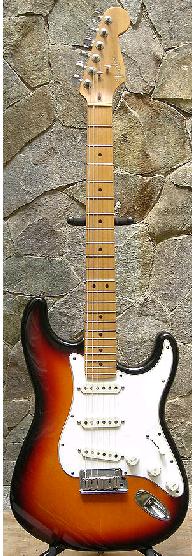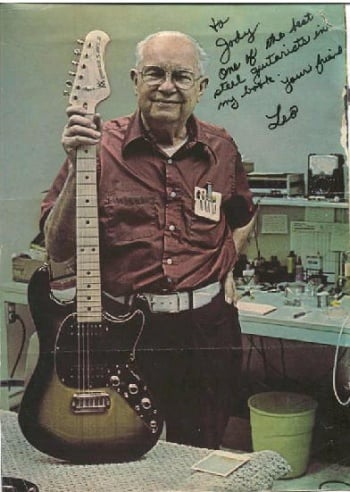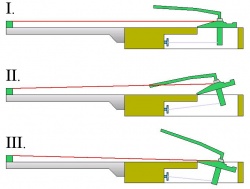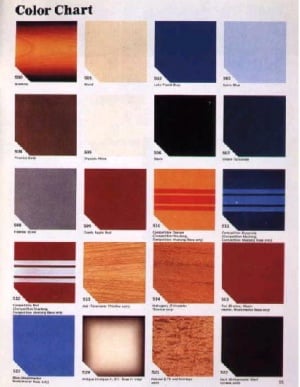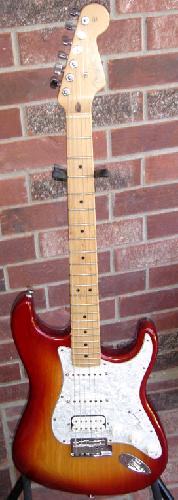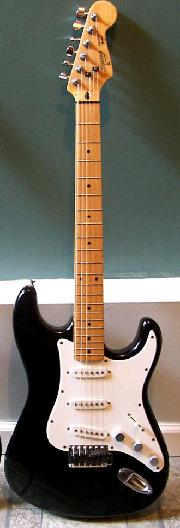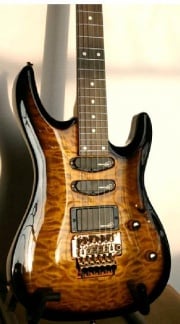Stratocaster
Contents |
Introduction
The Fender Stratocaster („Strat“) is a guitar that is produced since 1954 by the american brand Fender. When it appeard first it was taken as revolutionary cause of it's look. It's still produced today and can be called the most popular, most sold and also most copied guitar model. As good as every (famous) guitarist has played at any point of his career a Stratocaster or at least a copy. As it was produced in the beginning only in USA, today it's also produced in Korea, Mexico and Japan.
History
the early years
After Fender having had success with their first guitar Telecaster, Leo Fender (firm leader and founder) began in 1952 to develop a new guitar.
It must be said that Leo Fender was quite impressed and influenced by the car-industry; they brought out new models every year – and so did he: he thought of the development of the Telecaster to be finished and put all his effort in creating a totally new guitar.
He wanted to use all the experiences the company made with the Telecaster, to be able to make an even better guitar.
Besides that, the dealers wanted a better equipped (than Telecaster) high-quality instrument, that could keep pace with the Gibson Les Pauls.
The musicians who helped to develop the Stratocaster wanted a vibrato, more sound possibilities and also a better playability.
The basic idea of the Stratocaster was developed by Leo Fender, Freddie Tavares (product manager of Fender), George Fullerton (Co-Leader of Fender) and the two guitarists Bill Carson and Rex Gallion:
The body should get a futuristic form with a very long upper cornet to allow a better playability when playing staying. Even, that horn looked like the back of the big limousines.
From the guitarist Rex Gallion came the idea to make notches for the costals to achieve better playability
the headplate was also changed; it became asymmetric and very close to the design of P. Bigsby.
While Bill Carson wanted to equip the Strat with 5 pickups and Leo Fender wanted only 2, after long discussions on came together with 3 pick ups.
The Stratocaster became a plate vibrato system
The guitar cable was connected via a notch on the corpus top, because a lot of Telecasters had to be repaired because the jack socket was broken.
Prototype Problems
In 1953 when the first Prototypes were given to a number of certain guitatists, the results were bad: the plate of the vibrato system gulped all the vibration of the strings, what resulted in a very shrill and metallic sound. The guitarist Carson described the sound of the Stratocaster this way „It sounds like a cheap banjo in a plate-bin“ But Leo Fender had been so convinced by the plate-vibrato construction that he had already ordered 5000 plate rolls. It's said that they kept for years in the Fender storehouse.
Sucess came in
So after long discussions a new tremolo was developed.
The (revised) plate vibrato was used in the Jazzmaster and Jaguar models later on.
The new tremolo took one year to get started and was a very unflashy little „gadget“ and allowed the player by pressing down the vibrato-arm to let the strings to slacken completely. Besides that it improved the sound of the Stratocaster quite a lot.
In 1954 it was applied for a patent under the name „Tremolo“, not under the (correct) name „Vibrato“ - why isn't known.
At this point of time the name wasn't found.
The guitarist Bill Carson wanted the guitar to be named „Fender Bill Carson Model“ (like Gibson), but Leo Fender disliked this idea.
The futuristic sounding name Stratocaster was found as a mixture of the „TeleCASTER“ and the word „STRATOsphere“. In fact it has no deeper meaning. But the Fender advocates signed off on the name because there were no copyright violations to fear of.
The production began in 1954, the first advertisement for the new model was printed in April 1954 in the magazine „International Musician“. The price was 249$ plus additional 39$ for the case. The Telecaster had a price of 189$ in comparison.
Although the Stratocaster made a lot stir, it did not displace the Telecaster.
There was a lot of advertising but still more Telecasters than Stratocasters were sold.
This changed not until the 1970s – but up to today Stratocaster and Telecaster are produced parallel – although the Stratocaster was thought of initially as a follow-up model to the Telecaster.
After official digits of Fender in 1994 after the 50th anniversary of the Stratocaster, from 1-1.5million Stratocasters were produced and sold.
Development of the Stratocaster model
1954-1958
At first the Stratocaster was built of two pieces of ash. Since 1956 for the corpus is also used the lighter alder. The standard finish was a „2-tone sunburst“ that ran from yellow in the middle, to brown-black at the corners. Other colors or making the hardware golden were only available on order. The neck was one part of maple. There was no separate fretboard, it was placed directly on the neck. The truss rod to adjust the neck was placed in from the back, and the nut closed with a black stripe of wood. The pickup switch had only 3 positions; the combination of the pickups wasn't possible.
1958-1965
The biggest change was that the Stratocaster became a separate rosewood fretboard. At first there appeard some rifts occasionally, so the diameter of the fretboard was varied. Also the pickups were changed to ones with a higher power and an even warmer sound. In this period Fender started to work together with the chemical-concern „Dupont“, as a result it was possible to paint the Stratocaster in all „normal“ colors, and not only in the wood-colors. Besides that the „special“ finishes was taken to the normal offer under the topic „custom colors“. Expecially the finishes „Fiesta Red“, „Lake Placid Blue“ and „Surf Green“ became very popular.
1965-1985
In 1965 Leo Fender sold the whole Fender company to the concern Columbia Broadcasting System (CBS). As a result some changes that Leo Fender had prevented were pushed through: the 5-way toggle switch that allowed the Stratocaster to combine the single coils came in 1977.
Leo Fender didn't like the idea because he said the sound wouldn't be clear anymore if you combine the pick ups.
The musicians loved the changes, though.
Besides that there were made some changes with the neck construction and the fretboard. (Fretboards + necks out of maple only were buy-able again).
And because CBS tried to make more money with the Stratocaster, they bought cheaper material and enlarged the production tolerance. Because of that it came to big fluctuations in quality.
One idea to save money, was to use a cheaper wire for the pick ups. But the isolation material of the wire was melted in the wax-bath, the wires had to take during the production – this stabilisized the wire and prevented backcoupling usually. As a result, CBS didn't do the wax-bath anymore, so the pick ups hade a whistling-sound and „provoked“ backcouplings.
In the following time it came to embarrassing production flaws:
On a guitar with a transparent sunburst finish, you could read the pencil message of a quality-inspector: „Attention: knot-hole“ and the hideous place was circled.
This was the high point of the bad quality. Just at the end of the 1970s CBS tried to get their good image back.
Changes in 1985
The Fender firm was sold again – to the investor William Schultz, but he bought only the name(rights) and the remaining instruments + parts. The result was that the production stopped for a short period of time, until the new factory in Corona, California was built. This factory included a custom shop that was able to execute special customer wishes and limited special series.
1985 – today
The Stratocaster is the biggest way to make money for the Fender Musical Instruments Corperation.
That results in a very huge product spectrum.
Besides the re-building of nearly all building-phases there are countless specialeditions and new developed stratocaster models. At least the Fender instruments differ in the place they're produced. So is for example a american stratocaster more expensive than a mexian strat.
Most Important Fender Models
American Standard Stratocaster
This is one of the most popular actual models. It is in the style of the pre-CBS phase, but has some nice modern features, like better pick ups and a floating tremolo. The „American Deluxe Series“ model has a „S-1 switching system“ that allows parallel switchings (humbucker!). It gives also acces to the neck-bridge combination (telecaster-like sound).
Classic Stratocaster
This is the name for 3 modells that has each some features representing one decade of Stratocasters. There is the classic 50s Stratocasters with a on-neck fretboard, the classis 60s Stratocaster has a rosedwood fretboard and the classis 70s Stratocaster has a bigger head-plate and is available in the color „natural“, that was very popular in the 70s.
Fat Strat
This Strat contains instead of the third single coil a humbucker (HSS) and you achieve „fat“ sound with this guitat, therefore comes the name.
You get more pressure in your sound and it sounds more warm.
This type is very popular in rock / metal music in combination with a lot of distortion.
Highway One
This instrument is optically in the style of the 70s strat with all the typcial features, but has some more powerful singlecoils. It was designed for the country- and bluesrock music that was very popular in the 70s that uses sounds with little distortion.
Big Block Stratocaster
It has a humbucker in the bridge position and it's very blazing through some optical features: The instrument is plainted black – everywhere. And all the mechanics and the pickguard are chromed. In the fretboard you have big rectangular perlmut inlays.
Relic Stratocaster
„Relic“ is a term that stand for a series of product-types which look all sysnthetic artificial. That makes them look like an old collector-strat – even if they're new.
There are 3 different levels of aging beginnig with „New Old Stock“ over „Closed Classic“ goin to „Relic“.
The „New Old Stock“ series is wanted to make an impression, like forgotten for years and years in stock and now detected freshly. They make an unplayed impression, only yellowed plastic, old colors and dimmed mechanics differ them from the „normal strat“.
„Closed Classic“, an instrument is simulated, that is played by the pre-owner but has been in good care and forgotten.
Synthetic playing-ruts like kinks and rust on the mechanics are there also, but they're apart from this intact.
„Relic“ itself are instruments that look like they were live-instruments for decades; the finish is scratched, the fretboard shows playing ruts, the mechanics are rusted and the headplate has synthetic scorches from „forgotten“ cigarrettes.
The idea to sell used-style instruments comes – after a legend – from the Rolling Stones – they wanted for their World Tournee in 1994 called Voodoo Lounge the exact copies of their old instruments. As the re-built instruments looked much too new, they head to be made ancient optically.
Roland Ready Stratocaster
This is a Strat that is arised in cooperation with the brand Roland. The instrument has besides the 3 single coil pick ups a new hexaphonic Pickup, that can – in combination with an external ecletronic system – convert the playing signal into midi singnals. With this technique it's possible to make the guitar sound like completely differnet insturmens for example the piano, drumms or the trumpet.
Acoustrasonic Strat
This is an accoustic guitar, that hollow corpus has the form of a „normal“ stratocaster. Although this guitar has all features of a regular accoustic guitar, because of the small body, it's very silent and if played on stage it's amplified through a Piezo pick up normally.
Signature models
From the begining on, it was important for Fender, to see famous musicians play their instrments on stage. As in the beginning only normal Stratocasters were given to the musicians, later on the instruments were modified for the artisted and sold as signature xy modells. Most popular became these:
Eric Clapton
The base is a 50s stratocaster, this model has two important differneces: new electronic (two non-buzzing pick ups with elevation the midds) and the vibrato is put out of power with an wood block. This guitar was not only bought by Clapton Fans but also by professsional guitarists like Daryl Stuermer.
Jeff Beck
Comparable to Eric Clapton, Jeff Beck also put active electronics in his guitar, but in opposite Jeff Beck really likes the Vibrato system, so it' not only there, but replaced by a modern mounted on roller bearings tremolo system.
Richie Sambora
This instrument of Richie Sambora (he is the guitarist for Bon Jovi) was modified to get all the things you need to make a melodios Hardrock: It has a bridge humbucker to get a pressurefull, warm sound and a Floyd-Rose Tremolo to make all the crazy things like Divebombs etc with it.
Besides that he wanted to have star-inlays in the color of perlmutt.
Who likes it – buy it ![]() .
.
Matthias Jabs
As I'm German, this one i really important for me; the Scorpions guitaris got his own guitar, that in Germany is called for fun „Jabbocaster“. It has also a bridge-position humbucker and, like Richie Sambera extravargant inlays – guess what? They look like Saturn! This guitar is only available in red.
Jimi Hendrix
This guitar isn't a signature guitar in the usual sence, because it was presented 27 years after Jimis Death (rest in peace Jimi!) in 1997.
As Jimi was a left-hander, he played the normal guitars in wrong direction. Because in the 60s Lefthanders instruments were very expensive and not easy to get.
But there aren't as many lefthander-jimi fans, than right handers, the Jimi Henrix signature Strat is a reverse Lefthander strat. Even the „fender“ writing on the top of the guitar is printed mirror-inverted.
Ritchie Blackmore
The Deep-Purple guitarist got from Fender 2 signarue models: The earlier one is the same like the standard 1970s CBS Strat in white, but it has scalloped frets. Another thing is different: because Ritchie uses only neck and bridge pick up, the middle pick up was a fake only. The 2nd model had active electronics and the middle pickup position was empty. (looks like a telecaster).
Yngwie Malmsteen
This signature model is a copy of Malmsteens „Play Loud“ 1972' Stratocaster (it's also called „the Duck“) and has also scalloped frets. It has stratocaster-untipical 3 Dimarzio humbucker, that are in the form of Singlecoils, to keep the look.
Stratocaster copies
Other Brands
Since it's appearance the Stratocaster is the most copied guitar model. The Stratocaster shape is the figure a not playing human gets into his mind when thinking of an eguitar. To stick to facts, as good as every guitar manufacturer has or has had a guitar model inspired by the Stratocaster in his product range (Although Fender tries to stop the close copies of the Stratocaster helped by it's advocats). As a result all the Stratocaster copies have some minor changes. The one hand of producers are specialized on producing cheap beginnner „Stratocaster“s while the other hand does „Customizing“, that means improvement through higher quality material, better / other pick ups, a little different shape, glued necks and an original finish – to make visible on the first view that this isn't a series production, but a „special“ instrument. Famous examples are the brands „Valley Arts“ and „Sadowsky“ - check them out. But they never stick exactly to the Stratocaster form, they always have a little different shape hradplate or something similar, with the aim that Fender won't proceed them legally. But while there are still a lot of Stratocaster copies, Fender wanted to be able to make it's own Stratocasters in low-price range. This was the born of Squier.
Squier
Squier copies Stratocasters in Asia, and with cheaper materials, this has two effects: on the one hand the very cheap prices of Squier guitars, one the other hand less quality than original Fender ones.
Besides making copies of famous Fender instruments squier has by now also it's own product lines, that are only slack connected with the original Fender products.
Leo Fender
After Leo Fender had sold Fender, he couldn't stop to build guitars, and founded together with George Fullerton a new company again called G&L Musical Instruments (G&L = George & Leo).
They produced not Stratocaster-similar modells in the beginning, because Leo still thought, the Stratocaster was overrated and could be easily cleared out with another, „better“ model.
The „G&L Comanche“ had therefore some similarities with the Stratocaster but was improved by Leo in some certain aspects: The three pick ups had so called „Split ups“ that prevented them from buzzing and other background noises. The Tremolo was advanced and the guitar had lots of little knobs that allowed to influence the sound of the guitar massively.
Unluckly, a lot of those sounds were very metallic, hard and shrill, because Leo constructed the prototypes still with his own (abating) hearing.
This problem was solved when Leo bought himself a hearing aid – in the following times the instruments had their warm sound back.
Because those instruments were still not good-selling, the designers of G&L designed behind the back of Leo an instrument called „G&L Legacy“, that was an original Stratocaster, with only a better tremolo. As this instrument was good selling, Leo was happy with it;), and this is still one of the mainstays of this enterprise.
Stratocaster in art & design
In 1954 when the Stratocaser appeared first, the new design was revolutionary – in all areas.
The Stratocaster was the aximatic evidence, that a eguitar could have any shape. While the Gibson Les Pauls was still leant to the shape of the accoustic guitar, the Stratocaster encouraged all (guitar) designer over the world, to come up with new designed-guitars.
It's undoubtable, that without the Stratocaster, today there wouldn't be crazy looking guitars like the Flying-V or the Explorer.
Also the fact that the Stratocaster was available in all the normal colors, was a breaking to the accoustic-wood-looking guitars.
Besides that the term „Strat“ became a synonym for all strat-like guitars. In the beginning 1970s when Hardorock came up, the guitar brands started to adapt the Stratocaster to the new styles: 24 frets, a floyd rose tremolo, active electronics and the more powerful humbuckers were installed. Also the shape became more peaked and edged.
This „tuned“ instruments are called from musicians „Superstrats“. Famous manufactures here are Ibanez, Jackson, ESP or Framus.
In art the Stratocaster guitar became the timeless symbol of Rock'n'Roll and can be viewed on countless albumcovers, posters, buttons, comics (interesting; in the most comics you see a eguitar – it's a stratocaster!), as deco for discos, or even on toys.
The Jimi Hendrix Woodstock Strat
This instrument kept alive – in opposite to a lot of other guitars of this artist. The white guitar is in the hand of a collector and is said to be the most expensive instrument in the world. In 1993 it changed it's possesor for a price of today ~ 1.300.000 $(!).
GMC Strat Players
If you have a Stratocaster, write in your name, model and SN:
1. Milenkovic Ivan - 60th Anniversary American Strat - SN: Z6011934
2. Peter Leupold - American Deluxe Ash Body Stratocaster - SN: DZ9345381



